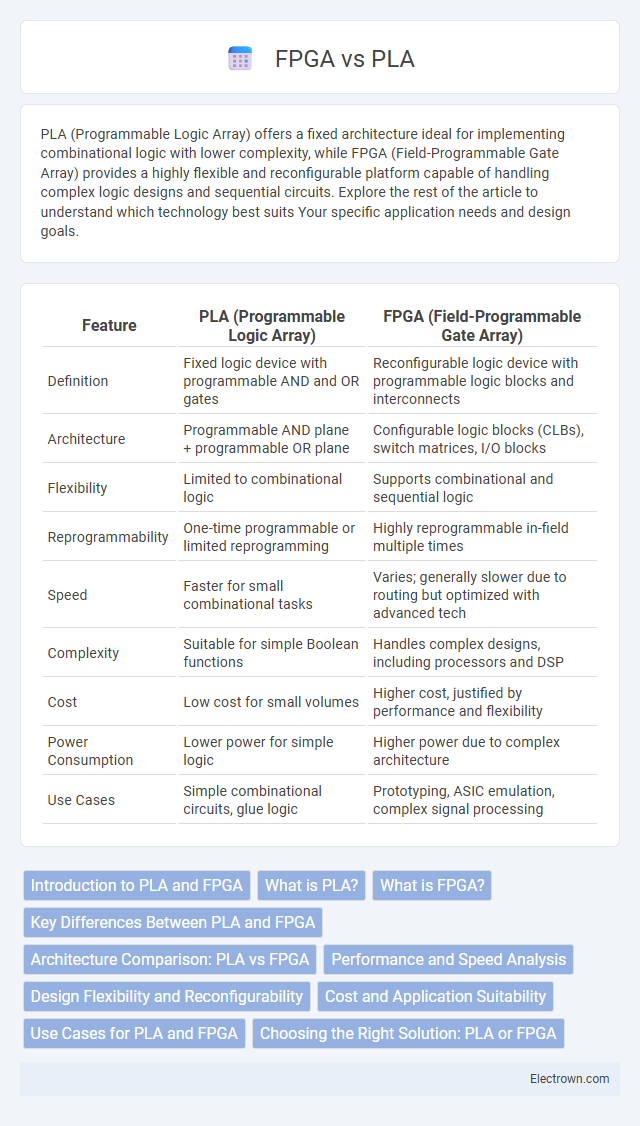PLA (Programmable Logic Array) offers a fixed architecture ideal for implementing combinational logic with lower complexity, while FPGA (Field-Programmable Gate Array) provides a highly flexible and reconfigurable platform capable of handling complex logic designs and sequential circuits. Explore the rest of the article to understand which technology best suits Your specific application needs and design goals.
Table of Comparison
| Feature | PLA (Programmable Logic Array) | FPGA (Field-Programmable Gate Array) |
|---|---|---|
| Definition | Fixed logic device with programmable AND and OR gates | Reconfigurable logic device with programmable logic blocks and interconnects |
| Architecture | Programmable AND plane + programmable OR plane | Configurable logic blocks (CLBs), switch matrices, I/O blocks |
| Flexibility | Limited to combinational logic | Supports combinational and sequential logic |
| Reprogrammability | One-time programmable or limited reprogramming | Highly reprogrammable in-field multiple times |
| Speed | Faster for small combinational tasks | Varies; generally slower due to routing but optimized with advanced tech |
| Complexity | Suitable for simple Boolean functions | Handles complex designs, including processors and DSP |
| Cost | Low cost for small volumes | Higher cost, justified by performance and flexibility |
| Power Consumption | Lower power for simple logic | Higher power due to complex architecture |
| Use Cases | Simple combinational circuits, glue logic | Prototyping, ASIC emulation, complex signal processing |
Introduction to PLA and FPGA
Programmable Logic Arrays (PLAs) are digital circuits used to implement combinational logic by programming a fixed set of logic gates in a defined array, ideal for simpler logic designs with low complexity. Field Programmable Gate Arrays (FPGAs) offer reconfigurable hardware with complex architectures composed of configurable logic blocks, making them suitable for high-performance and versatile digital applications. Your choice between PLA and FPGA depends on factors like design complexity, speed requirements, and flexibility needed for the project.
What is PLA?
A Programmable Logic Array (PLA) is a type of digital logic device used to implement combinational logic circuits by programming both the AND and OR gates. Unlike FPGAs, which consist of an array of configurable logic blocks and interconnects, PLAs have a fixed structure with programmable connections, making them efficient for simpler, specific logic functions. Your choice of a PLA offers deterministic performance and lower complexity when implementing custom Boolean functions.
What is FPGA?
Field-Programmable Gate Arrays (FPGAs) are integrated circuits designed to be configured by the user after manufacturing, enabling customized hardware functionality. Unlike Programmable Logic Arrays (PLAs), FPGAs consist of an array of programmable logic blocks and interconnects, allowing for parallel processing and complex digital circuit implementations. FPGAs are widely used in applications requiring high performance, flexibility, and reconfigurability, such as telecommunications, signal processing, and embedded systems.
Key Differences Between PLA and FPGA
PLA (Programmable Logic Array) is a fixed architecture device primarily designed for implementing combinational logic with a predetermined array of AND and OR gates, offering limited flexibility and lower density. FPGA (Field-Programmable Gate Array) features a highly flexible structure with an array of configurable logic blocks, interconnects, and I/O blocks, enabling complex digital circuit designs and reconfigurability at the hardware level. FPGAs provide higher speed, greater scalability, and support for sequential logic, whereas PLAs are simpler and suited for basic, static logic functions.
Architecture Comparison: PLA vs FPGA
Programmable Logic Arrays (PLAs) feature a fixed two-level structure with separate programmable AND and OR planes, enabling simpler and faster logic implementation for specific combinational functions. Field-Programmable Gate Arrays (FPGAs) consist of a highly flexible array of configurable logic blocks (CLBs), interconnects, and I/O blocks, supporting complex designs with reconfigurable routing and embedded memory. The architectural difference lies in PLA's fixed function plane design versus FPGA's modular, hierarchical fabric, offering superior scalability and adaptability for diverse digital applications.
Performance and Speed Analysis
FPGA devices generally offer higher performance and faster processing speeds compared to PLA due to their parallel architecture and ability to be reconfigured for specific tasks. PLAs, while simpler and more cost-effective for fixed logic functions, have limited speed and throughput because of their fixed programmable logic arrays. Your choice between PLA and FPGA should consider the required speed, with FPGA being preferable for high-performance applications demanding rapid and flexible signal processing.
Design Flexibility and Reconfigurability
PLA offers limited design flexibility due to its fixed logic structure after fabrication, making it suitable for simpler, static applications. FPGA provides extensive design flexibility and reconfigurability, allowing you to modify and optimize hardware functionality multiple times post-manufacturing. This adaptability makes FPGAs ideal for complex systems requiring frequent updates or custom configurations.
Cost and Application Suitability
PLA devices are generally more cost-effective for simple, fixed logic functions due to their straightforward design and lower manufacturing complexity. FPGA technology offers greater flexibility and reconfigurability, making it suitable for complex, high-performance applications despite higher initial costs. Your choice depends on whether budget constraints prioritize affordability or if adaptable processing power demands justify the investment in FPGA solutions.
Use Cases for PLA and FPGA
PLAs (Programmable Logic Arrays) are ideal for implementing fixed combinational logic functions in small-scale applications, such as simple control circuits and basic address decoding, due to their cost-effectiveness and ease of programming. FPGAs (Field-Programmable Gate Arrays) excel in complex and large-scale digital designs, including signal processing, embedded systems, and prototyping, offering high flexibility with reconfigurable logic blocks and parallel processing capabilities. Your choice depends on the required complexity and scalability of the application, with FPGAs providing greater versatility for evolving system designs.
Choosing the Right Solution: PLA or FPGA
Choosing the right solution between PLA and FPGA depends on the complexity, flexibility, and volume of the intended application. PLAs offer cost-effective, high-speed logic customization for fixed-function designs with lower gate counts, making them ideal for simpler, low-volume projects. FPGAs provide advanced reconfigurability and support for complex, large-scale systems with millions of gates, making them suitable for adaptive, high-performance digital circuit implementations in evolving applications.
PLA vs FPGA Infographic

 electrown.com
electrown.com